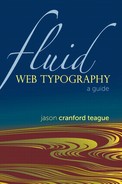Guiding the Reader’s Eye
The purpose of type is to portray the glyphs of a written language for reading by human beings. Beyond creating readable text that communicates your message, one of the other chief goals of great typography is to help guide the readers’ eye around the page, helping them scan and find the content they are looking for.
Font Family
The collection of all fonts with the same name, but different weights, styles, variants, and stretch. The base font of the family is referred to as the Roman version.
Scannability is an important factor in all Web typography, almost as important as readability. Research shows that people read differently onscreen than they do in print, tending to want to access shorter chunks of content at a glance.

Typography as a design element
In the 1970s and 80s′, the photocopy machine came into its own as a way of quickly reproducing content on a large scale. Although they had been around for decades, it was during this period that the price became low enough that access was not only easy but common. Up until then, typography had been the domain of “professionals” who took their craft seriously (possibly a little too seriously). The ubiquity of the photocopier led to a lot of experimentation. Type was often used not just to communicate a written message but also as a part of the design itself, sometimes divorced from specific textual meaning’.

Ray Gun Magazine
The now-defunct magazine Ray Gun was renowned for its experimental typographic styling, which helped spearhead the grunge design movement of the early 1990s.
Of course, the use of text for ornamentation was nothing new, but with the advent of mass reproduction came a whole new style: The “grunge” design movement of the 1990s was best exemplified in the rock news magazine Ray Gun and had a strong impact on early Web design, coinciding with and influencing the burgeoning field of Web design especially in the United States.
There is a lot of debate about using typography for decoration, and not just for clearly informational purposes. Some say that using type decoratively adds design texture, while others argue that it just adds noise. It will be up to you to decide how much (if any) text ornamentation will add emphasis and contrast to your designs. Don’t be afraid to experiment.
Readability vs. legibility vs. scannability
Legibility, readability, and scannability are often thought of as synonyms, but in Web typography, it is important to separate them.
Legibility: Type that is well designed and easily discerned. This is the responsibility of the type designer.
Readability: Text that is easy on the eyes for the purposes of reading, especially over large blocks of text. This is the responsibility of the typographer.
Scannability: Text that can be quickly surveyed for information relevant to the reader. This is also the responsibility of the typographer.
Eye Tracking
Web designers often study how a reader’s eye moves across the page in response to visual stimuli, with places where the eye rests being of particular interest. Such eye-tracking studies help us better understand how to help guide the user to important information.
All three are important for successful content, but it is the last two that are where we apply typography, especially font weights, italics and obliques, decorations, text case, and color. Typography can either guide the reader’s eyes around the page or obstruct their path.

